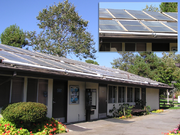This is part of a series of brief posts on ‘clean energy jobs‘ opportunities for sparking meaningful employment, quickly, in the United States as discussed in Clean Energy Jobs: Stimulate Me.
Clean Energy Jobs Go To The Cleaners: $50 million per year for 9,000 jobs
Coin-operated laundromats almost require rivers  to operate, with their industrial-like washing machines gobbling up 60 gallons or more of water. And, since there is no incentive for those pumping in quarters to go cold, rather than hot, we’re actually talking about rivers of steaming water. That water heating requires a lot of energy, typically coming from natural gas water heaters. When it comes to active solar power, heating water (or, at times, preheating water) is currently one of the most cost effective paths in
to operate, with their industrial-like washing machines gobbling up 60 gallons or more of water. And, since there is no incentive for those pumping in quarters to go cold, rather than hot, we’re actually talking about rivers of steaming water. That water heating requires a lot of energy, typically coming from natural gas water heaters. When it comes to active solar power, heating water (or, at times, preheating water) is currently one of the most cost effective paths in  terms of energy value per dollar of investment. Laundromats (and other institutional laundries, such as hospitals) are prime places for solar hot water due to the high volume, 365 days a year water usage. And, there a number of solar hot water systems already in place in laundromats (such as this huge one in Chicago (proclaimed as the world’s largest laundromat) and this laundromat/car wash in Jamaica Plains, MA (pdf)). As for the last, due to federal and state incentives, the payback period should be less than five years while ensuring the owner against fluctuating energy prices.
terms of energy value per dollar of investment. Laundromats (and other institutional laundries, such as hospitals) are prime places for solar hot water due to the high volume, 365 days a year water usage. And, there a number of solar hot water systems already in place in laundromats (such as this huge one in Chicago (proclaimed as the world’s largest laundromat) and this laundromat/car wash in Jamaica Plains, MA (pdf)). As for the last, due to federal and state incentives, the payback period should be less than five years while ensuring the owner against fluctuating energy prices.
Yet, laundromats are one of those classic split incentive situations which can hinder making longer term investments toward energy efficiency. It is hard for any business to invest for a long-term ROI, perhaps especially one that is relying on quarters going into slots in a constant chime. And, it can be hard for small businesses to secure long-term financing that might enable them to do even something that should provide a five-year return on investment. Perhaps one percent of laundromats are using solar hot water heating when it might make sense for the vast majority of the 35,000 U.S. coin-operated laundromats.
The question then: how can we spark laundromat use of solar hot water, cost effectively, in a way that will get people to work and help cut into our greenhouse emissions while earning owners more money and helping cut the costs of those on the lower economic end of the spectrum who are using these services? A multifaceted approach could do the trick:
- Increase federal assistance for commercial solar hot water systems for laundry services by 5% for 2010 and 2011 (to 35% of cost) to highlight a fiscal benefit and make this an upfront payment rather than a tax credit.
- Additional assistance through Federal loan program availability to provide an interest rate of six percent for funding these loans.
- Provide 95% funding that would be paid-back via real-estate taxes over a 12 year period
Very quickly, the math:
- Assume $100,000 average cost for installed system.
- Federal costs per system:
- $5,000 per system cost for additional federal money with an additional $1500 implied cost for moving from tax credit to ‘cash payment’ system.
- Additional $3500 implied cost through assistance for lower interest rate.
- Thus, each $10k of additional Federal government cost to spark $100,000 in local business activity.
- At 18 jobs per $1 million, each $100k of Federal cost creates 18 direct and indirect jobs.
- $50 million in additional funding per year would spark $500 million into commercial solar hot water systems through supporting 5,000 laundromats moving to solar hot water systems each year.
- This $50 million in funding would support 9000 jobs spread throughout the United States.
In addition to the jobs benefits, this program would help foster renewable energy services’ capacities throughout the United States, help reduce greenhouse gas emissions, spark increased small-business profits, and potentially lead to lower costs for laundromat users.
This program can easily be expanded to support other large water demand services (such as hotel, hospital, and other commercial laundries) with similarly high payoffs in terms of job creation and sparked economic activity per dollar invested.
Clean Energy Jobs Go To The Cleaners: $50 million per year for 9,000 jobs
Clean Energy Jobs series posts:
